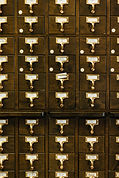The Catholic Church traces its origins to Jesus Christ and his apostles, citing Peter as the first leader of the church.

Website
History
The Catholic Church is the largest Christian church, with a history that spans over two millennia. The Catholic Church traces its origins to Jesus Christ and his apostles, citing Peter as the first leader of the church, appointed by Jesus himself. It was the original organized Christian church until the church split into the Eastern Orthodox and Western Roman Catholic Church in the 11th century and the Protestants separated off during the Reformation in the 16th century.
Origins with Jesus and the Apostles
The Catholic Church believes it was founded by Jesus Christ around 30 AD, who, according to the New Testament, appointed Peter as the first leader of his followers (the first pope) with the famous words, “You are Peter, and on this rock I will build my church” (Matthew 16:18). After the death and resurrection of Christ, his disciples spread the Christian message across the Roman Empire.
Early Persecution
Early Christians faced waves of persecution by Roman authorities, especially under emperors like Nero and Diocletian, as they refused to worship Roman gods. Despite this, Christianity spread rapidly across the empire, due to its message of salvation and the dedication of missionaries like Paul the Apostle.
Formalizing Doctrine
The Roman Emperor Constantine converted to Christianity in the early 4th century and issued the Edict of Milan in 313 AD, which legalized Christianity in the empire. The First Council of Nicaea in 325 was convened to address heresies like Arianism and to affirm core Christian beliefs, including the divinity of Jesus. This led to the Nicene Creed, a foundational statement of Christian faith.
The Papacy and the Holy Roman Empire
As the Roman Empire declined and eventually fell in the 5th century, the bishop of Rome, later known as the pope, became increasingly powerful. Figures like Pope Leo the Great (440–461) and Pope Gregory the Great (590–604) helped solidify the authority of the papacy, providing spiritual leadership and, at times, temporal leadership in the vacuum left by Rome’s collapse. The close relationship between the church and political rulers grew when Charlemagne was crowned emperor by Pope Leo III in 800 AD, forming the Holy Roman Empire. This period marked the height of Christendom, where the Catholic Church and European kingdoms were tightly intertwined.
The Great Schism: The Roman Catholic Church Separates from the Eastern Orthodox Church
In 1054, tensions between the Western (Latin-speaking) and Eastern (Greek-speaking) branches of Christianity culminated in the Great Schism. This division resulted in the separation of the Roman Catholic Church in the West and the Eastern Orthodox Church in the East, primarily over issues of papal authority and theological differences.
Crusades
Beginning in 1095, the Catholic Church launched a series of military campaigns, called the Crusades, to reclaim the Holy Land from Muslim control. Although the Crusades were a mixture of religious fervor, political ambition, and economic interests, they profoundly influenced both the church and Christian-Muslim relations.
Scholasticism and Theology: The medieval period was also marked by significant intellectual and theological developments. The work of St. Thomas Aquinas (1225–1274), particularly his Summa Theologica, laid the groundwork for Catholic theology. Scholasticism, which sought to harmonize faith and reason, was the dominant intellectual movement of the era.
4. The Renaissance and Reformation (16th – 17th Centuries)
The Renaissance saw a resurgence of art, science, and humanism in Europe, with many popes becoming patrons of the arts. However, corruption within the church (e.g., the sale of indulgences, nepotism, and moral decline among clergy) led to widespread criticism. In 1517, Martin Luther, a German monk, nailed his 95 Theses to a church door, challenging practices within the Catholic Church, particularly the sale of indulgences and the authority of the pope. This act sparked the Protestant Reformation, leading to the formation of Protestant denominations like Lutheranism, Calvinism, and Anglicanism.
Beliefs
The Pope
The Catholic Church recognizes the pope as the successor of St. Peter and the leader of the global church.
The Sacraments
The church teaches that there are seven sacraments, including baptism, Eucharist (Communion), and marriage.
Apostolic Tradition
Catholics believe in the importance of both Scripture and Tradition in conveying the teachings of Christ.
Transubstantiation
The belief that, during the Eucharist, the bread and wine become the actual body and blood of Christ.
Membership
The Catholic Church is the largest Christian denomination in the world with approximately 1.3 billion baptized members worldwide, accounting for about 17.7% of the global population.
Liveology® creates uplifting content and products for abundant life. Shop our all natural bodycare, handmade products, and spiritual apparel! Subscribe for access to our wealth of articles and videos on victorious living. Thank you for your continued and growing support all over the world.
Peace & Love!
























Comments